
Hirudo medicinalis, the European medicinal leech, is one of several species of leeches used as "medicinal leeches".

Hirudin is a naturally occurring peptide in the salivary glands of blood-sucking leeches that has a blood anticoagulant property. This is fundamental for the leeches’ alimentary habit of hematophagy, since it keeps the blood flowing after the initial phlebotomy performed by the worm on the host’s skin.

Aeromonas is a genus of Gram-negative, facultative anaerobic, rod-shaped bacteria that morphologically resemble members of the family Enterobacteriaceae. Most of the 14 described species have been associated with human diseases. The most important pathogens are A. hydrophila, A. caviae, and A. veronii biovar sobria. The organisms are ubiquitous in fresh and brackish water.
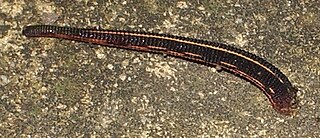
Euhirudinea, the true leeches, are an infraclass of the Hirudinea. These clitellate annelids are of somewhat unclear relationships; namely the relationships of Hirudinea with oligochaetes are in need of revision. It may be that the presumed sister taxon of the Euhirudinea, the Acanthobdellidea, turns out to be more distantly related, as was already the case with the Branchiobdellida. Thus, eventually Euhirudinea might become a junior synonym of Hirudinea.

The proboscisless leeches, Arhynchobdellida, are classified as an order of the Hirudinea. But leech taxonomy and systematics will eventually be revised in due time, not because there are many uncertainties about their phylogeny, but because the major clades of clitellate annelids - and whether the clitellates are themselves a clade - have not been fully elucidated. For example, the "true leeches" (Euhirudinea) might actually be synonymous with the Hirudinea, as all other leech-like annelids might not be very closely related to the true leeches.
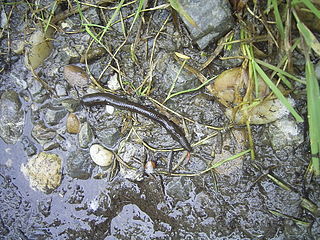
The Hirudiniformes are one of the currently-accepted suborders of the proboscisless leeches (Arhynchobdellida). Their best-known member is the European medical leech, Hirudo medicinalis, and indeed most of the blood-sucking "worms" as which leeches are generally perceived belong to this group. In general, though some leeches suck blood, many are predators which hunt small invertebrates.
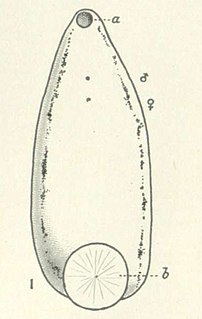
Hirudobdella antipodum is a terrestrial leech found only on the Open Bay Islands in New Zealand. It preys on the feet of nesting seabirds. Its numbers have been reduced significantly by introduced weka, and the entire remnant population of the leech is now living beneath a single boulder.

Blatačko Lake is a natural lake 21 kilometers to the north-east of Konjic, in Konjic municipality, Bosnia and Herzegovina. The lake is a central feature of the natural & cultural-historical ensemble - cultural landscape - designated as National Monument of Bosnia and Herzegovina.

A leech collector, leech gatherer, or leech finder was a person occupied with procuring medicinal leeches, which were in growing demand in 19th-century Europe. Leeches were used in bloodletting but were not easy for medical practitioners to obtain. The collector would sometimes gather the leeches by attracting them to the legs of animals, often old horses. More commonplace was for the collector to use their own legs, gathering the leech after it had finished sucking enough blood. Many in the profession suffered from the effects of the loss of blood and infections spread by the leeches.

Hirudo verbana is a species of leech.
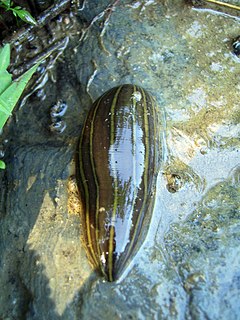
Hirudo is a genus of leeches of the family Hirudinidae. It was described by Linnaeus in 1758.
Hirudo orientalis is a species of medicinal leech. It has confused with Hirudo medicinalis, but has recently been recognized as different species. This Asian species is associated with mountainous areas in the subboreal eremial zone and occurs in Azerbaijan, Iran, Uzbekistan and Kazakhstan. It occurs also in Georgia, and probably in Armenia.

Hirudinidae is a family of leeches. It contains ten genera.

This late Georgian Bedale Leech House in Bedale, North Yorkshire, England, is a unique example of a building constructed to keep live medicinal leeches healthy prior to their sale by the local apothecary to doctors and private individuals for the purpose of blood letting as a medical procedure to cure or prevent a variety of illnesses and diseases.
Kaistia hirudinis is a Gram-negative and rod-shaped bacterium from the genus of Kaistia which has been isolated from a leech from the Leech Breeding Station in Biebertal in Germany.
Flavobacterium cutihirudinis is a Gram-negative bacterium from the genus of Flavobacterium which has been isolated from the skin of a leech Hirudo verbana from Biebertal in Germany.
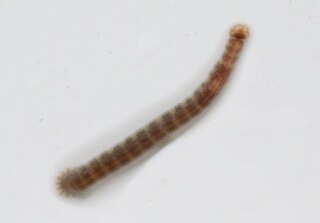
Piscicola geometra is a species of leech in the family Piscicolidae. It is an external parasite of marine, brackish and freshwater fishes. It was first described as Hirudo geometra by the Swedish naturalist Carl Linnaeus in his Systema Naturae in 1758.
Mucinivorans is an anaerobic bacterial genus from the family of Rikenellaceae with one known species. Mucinivorans hirudinis has been isolated from the digestrive tract of the leech Hirudo verbana.














